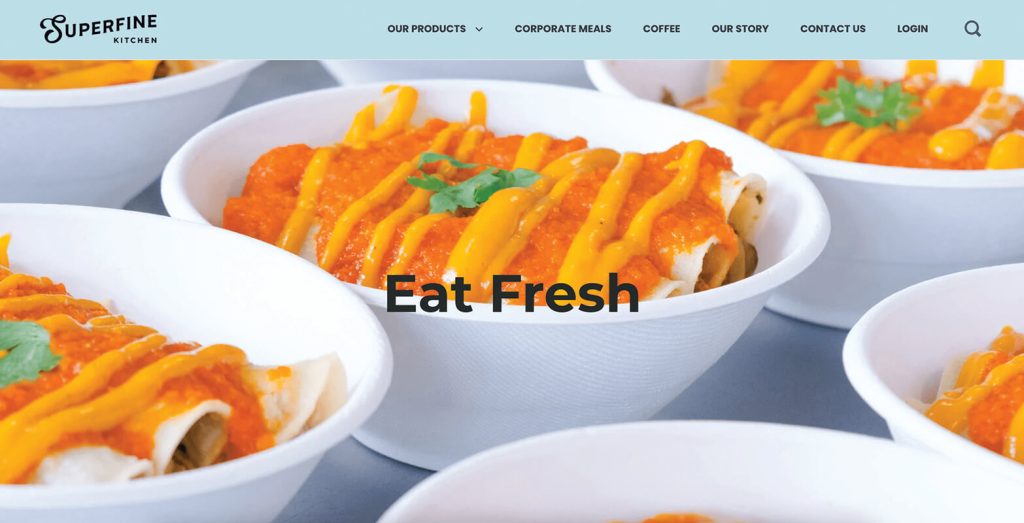In this comprehensive guide, you’ll learn about the different types of catering businesses and how to set one up successfully. It’s perfect for those interested in running a catering business of their own but are unsure of how to get started.
We will share interesting facts about the catering industry to set the right expectations and provide examples of successful catering businesses you can learn from. During the conclusion of our guide, you’ll learn the recommended steps for setting up a catering business.
Overall, it’s a worthwhile read to ensure there are no nasty surprises during the launch phase and you cover the basics.
What Is a Catering Business?
At its core, a catering company comprises a team of chefs and the logistics side that takes care of cooking, packaging and delivering food to the client. However, there is a lot more to the process when you take a closer look.
Catering businesses serve various customer types, as you’ll learn in the following section. Some have an all-in-one approach that services various industries, while others concentrate on specializing in specific niches – this could be weddings, schools, or work functions.
The main difference between a catering business and a restaurant is that the catering business normally doesn’t hold a store front. They operate as a food manufacturer in the sense that the food is consumed off premise (external to the location where the food is made). Some restaurants have the ability to run a catering business inside its location too, but the catering orders will most certainly be consumed off premise – the logistics consists of pick up or delivery.
Different Types of Catering Businesses
Not sure what type of catering business to start? Now we’ll dive deeper into the different types of catering businesses. This might give you a few ideas for which direction to take on your journey.
Corporate Catering / Off Premise Catering
This catering business type is usually in the form of a delivery service. The food is produced in the restaurant and consumed outside (hence the term ‘off premise’). The focus is on bringing the food experience to the client for convenience, generally home or office. Typically, these services are used for deliveries to the workplace of orders pre-booked a couple of days in advance or home parties. In the US, several restaurant chains have a somewhat established catering sales channel. That is not the case in other countries like Australia.
Clients and caterers agree on a predetermined menu and arrange the delivery of food (typically facilitated by an online ordering and catering software). The amount of staff required to run this type catering business is typically lower once the business is using established infrastructure and staff already working at the restaurant.
Full-service catering
This catering company type is independently owned and is responsible for all aspects of the event, including event management, equipment hire, decorations, food preparation and menu design. They handle events like weddings, birthday parties, personal anniversaries, business holiday events and much more. The caterer will likely be present during the event serving the food and managing the event running schedule.
Food Truck or Cart
This catering business type relocates a portable kitchen (normally a converted truck) to the event location. The aim is to cook fresh and allow the flexibility of customers to choose their meal on the spot. Meals don’t need to be pre-booked. This type of catering business is mostly used for outdoor events and festivals. Occasionally, you see the food trucks around city parks. Food trucks can provide a good source of income and be lots of fun to run. But they are harder to scale.
Restaurant/hotel conference catering
This catering business type, also known as venue catering, normally takes place at an intermediate venue such as function hall/restaurant/hotel (and cemeteries too). Some of the roles of the catering company include decoration delivery, banquet arrangement, table setup and menu design and preparation. The caterer will likely be present during the event serving the food and managing the event running schedule.
Airline Catering
The name is self explanatory. This type of catering company is focused on service food for the aviation industry. This industry is dominated by a few players who control the contracts with the airlines. In saying that, they outsource some of their food production to smaller catering companies, providing a genuine opportunity for smaller catering companies to supply the ones who own the contract.
Features of a Catering Business
In this section, we will explore the various features and responsibilities of catering companies. This gives you an idea of what services such businesses must provide and what is expected by clients.
- Food and beverages: the core feature of a catering company is the food and beverages. A good quality service should have plenty of options and offer recommendations to clients that are unsure of what they want. Also, catering companies should do a good job of helping match the food with the right beverages so they complement one another.
- Accommodate various numbers of guests: catering companies should have the capacity to accommodate a large number of guests and ensure that food is served to each guest promptly and to the right quality levels.
- Food safety: caterers are responsible for the safety of the food that’s provided to the client. This includes avoiding handing out food where guests are allergic and ensuring the food is fresh and uncontaminated.
- Creativity: food might only be part of the event – whether it’s a celebration or a business meeting, the correct tone must be struck. Catering companies can add to the atmosphere by offering decorations, props, and other ideas that add to the occasion.
- Adaptability: typically, clients have specific preferences for how they want the event to unfold. Also, unforeseen circumstances might require changing the menu or the number of guests. The best catering companies will have the adaptability to meet the new demands.
- Good value: the catering business is very competitive in most areas of the world, so the pricing must be fair. If you want to charge more than the competition, then there must be some feature that allows you to stand out in the market.
- Professional team: it’s the individual team members that will put the event together and bring the menu to life. Therefore, you need to pick employees that have experience and are up to the task.
- Systems: the caterers should have good systems to be able to store all the data points related to an event such as dietary requirements, customer notes, running schedule and more. In addition the system should provide an ability to provide a proposal to the customer. Ideally the caterer will have an all-in-one software where all the event and food information is stored and easily accessible.
Catering Business Market Data
Now let’s look at a few interesting catering statistics to get a better idea of what the industry is about.
- Catering Services estimated at US$494.5 Billion in the year 2020. (Source: PR Newswire)
- Catering Services is projected to reach a revised size of US$609 Billion by 2027, growing at a CAGR of 3% over the period 2020-2027. (Source: PR Newswire)
- The Catering Services market in the U. S. is estimated at US$133.6 Billion. (Source: PR Newswire)
- The Catering Services market in Australia. is estimated at US$ 9 Billion. (Source: Ibis World)
- Catering industry will grow by more than USD 115 billion from 2020 to 2027: the large levels of growth over the next few years means it’s a great time to be in catering.
- Only 5% of capital is spent on labor costs: this indicates that the catering industry has the potential for high margins and could be a lucrative business model with the right approach.
- Average business owners work 59 hours per week: being a business owner in this industry means long hours.
- 50% of catering businesses own their own kitchen facilities: this statistic indicates that many catering companies rent facilities or outsource the meal preparation from other companies.
- Average party size of catering company clients is 50-200 people: the large party size indicates that most clients hire catering companies for big events. Therefore, successful catering companies must have the capacity to accept a large number of guests.
Examples of Catering Business
Want to know what a successful catering business looks like? It’s a good way to get motivated to start a company of your own and open your mind up to the possibilities.
Nicholas Seafood (Sydney, Australia): this catering company is considered to be a household name and is focused on delivering food to the workplace. Located in the renowned Sydney Seafood Market they provide fresh seafood platters to businesses in Sydney. They also offer home delivery for parties and events.

Superfine Kitchen (San Francisco, USA): the focus of this catering company is on servicing groups of people within companies in San Francisco, CA. Offering several brands, the menus are predefined and subsidised by the companies, The company staff can then go to the website and order online. The company discount (or subsidy) is automatically to the customer account. The food is cooked by quality chefs, and photographs are taken of actual food in containers as they would be presented to the client.

Parakeet Cafe (San Diego, USA): catering business that is geared toward office lunches and events. Through several bricks and mortar stores in San Diego, Parakeet offers off premise catering services with a focus on health and wellness.

Compass Group (Surry, England): the largest catering company in the World. Founded in 1941 and headquartered in Surrey, England, Compass Group specializes in food and support service and employs more than half a million people worldwide. As of November 2016, Compass Group’s revenue amounted to USD 24.7 billion U.S. dollars.

This is how Tommy Ruff, a fish bar chain in Melbourne, Australia is running their off premise catering business.
Is It Hard To Start a Catering Business?
It is not hard to start a catering business if you have the right skills and/or infrastructure in place. Business experience is always good to have, but you can also learn it as you go. Once you go through the business setup, promoting and marketing your business will be essential to long term success.
If you are starting a catering business from scratch, it is normally recommended that you have hospitality experience and/or cooking experience. You can then follow the recommended steps in the post to set up the business, promote it and start fulfilling orders.
If you have a business in the hospitality industry and you would like to expand into the catering business, that is a great opportunity. You can leverage your existing infrastructure, kitchen and team and focus on promoting the catering services.
Steps to Establish Your Catering Business
Let’s embark on a culinary journey of setting up a business in catering, where each step will have a flavor of its own.
Step 1: The Dream Spark
First, let’s start with a story. Emily, a talented chef from San Francisco, had always been praised for her culinary skills.
Her close-knit community adored her baked salmon and creamy risotto. They often joke, “Emily, if you ever start a catering business, you’d have us lined up daily!” That very idea, that very seed, started what today is a multi-million dollar catering venture.
Your catering business might have started as a spark too. Maybe it was a dish you made, a comment someone passed, or perhaps it’s a passion that’s been brewing for years.
The first step to establishing any company, especially in the catering world, is recognizing and believing in that spark.
Step 2: Research & Market Analysis
The world of the catering business is vast. From corporate events, lavish weddings, to small community gatherings, opportunities are endless.
For instance, did you know that the catering business is projected to grow annually at 5.3%? Or that weddings account for the largest catering segment, contributing to a whopping 32%?
By identifying your niche – whether it’s vegan dishes, local cuisines, or grand wedding feasts – you can tap into specific markets and serve them with finesse.
Step 3: Legalities & Paperwork: Setting A Strong Foundation
When Emily started out, she was wary of the legal intricacies involved. But then, she came across an intriguing fact.
In the U.S, approximately 20% of small businesses fail due to overlooking legal compliance and licensing issues.
Just as you wouldn’t want your soufflé to collapse because you missed an ingredient, you wouldn’t want your business to falter due to overlooked paperwork.
Getting the required permits, ensuring health and safety standards, and being tax compliant are essential building blocks for your catering business.
It might seem tedious, but believe me, it’s better to spend time now than regret it later.
Step 4: Location & Infrastructure
While most of the magic in a catering business happens in the kitchen, it’s not the only place you need to think about. Your business’s location is like your website’s landing page. It needs to be optimized for conversions.
Now, I’m not saying you need a fancy, high-street locale. But understanding footfall, accessibility, and even the vibe of a place can make all the difference.
Remember, your kitchen is where you create, but your entire infrastructure is where you innovate.
Step 5: Branding & Identity
In today’s digital age, your branding is your first impression. Emily realized this when she saw a competitor’s catering service get more traction due to stronger branding, even though many believed her dishes were superior.
Your logo, your company’s name, even the design of your menu – these aren’t just peripheral things. They are representations of your catering business’s soul.
An insider tip? Go beyond just aesthetics. Incorporate elements that resonate with your target audience.
For instance, if you’re targeting corporate events, a sophisticated, minimalistic design might work best.
On the other hand, if local community gatherings are your forte, a more homely, organic design could be the way to go.
Step 6: Networking & Building Connections
Let me share a lesser-known fact. About 65% of catering businesses get their first significant contract through a connection or a reference.
It’s not just about the food; it’s about the trust. The trust that you’ll deliver on time, manage logistics smoothly, and offer an experience, not just a service.
Attend community events, join local business associations, or even host tasting sessions. The aim is to make your catering business synonymous with reliability and quality in people’s minds.
Step 7: Get a Catering Software
You’ll most definitely need a robust catering software to allow you to run your business data on the Clouds.
A catering software will have features such as menu management, event management, order management, CRM to manage your customers and contacts and reports for the kitchen, sales and finance.
In addition, depending on what type of catering business, you will need an online ordering system and accounting software such as QuickBooks to lodge your tax. If you are running a more catering business robust operation, you should choose a software with third party integrations.
Read More: 12 Steps on How to Build a Catering Business
FAQs
How do I start a catering business from home?
Starting a catering business from home requires careful planning. Begin with understanding your niche, obtaining the necessary permits and licenses, and ensuring you have the right kitchen equipment. Marketing and building a client base are essential next steps.
Is a license required to operate a catering business?
Yes, a license is typically required to operate a catering business. Apart from a business license, you might also need food handling and health permits, depending on your local regulations. It’s crucial to check with local authorities to ensure compliance.
How do I price my catering services?
Pricing for catering services should account for ingredient costs, labor, overheads, and profit margins. Research competitors’ prices and consider your unique selling proposition. Always ensure that you maintain a balance between competitive pricing and profitability.
How can I market my catering business effectively?
Effective marketing for your catering business involves a mix of online and offline strategies. Create a compelling website, engage with potential clients on social media, and network at local events. Additionally, word-of-mouth and customer testimonials can be powerful tools.
What are the major challenges in the catering business?
Major challenges in the catering business include fluctuating demand, maintaining food quality, managing event logistics, and staying updated with the latest food trends. It’s essential to be adaptable, continually refine your business strategy, and prioritize customer satisfaction.
Final thoughts
In conclusion, catering companies serve an important role that will never be obsolete. Therefore, setting up a catering company is a good bet if you take the right approach.
The data shows significant growth of the catering business industry in the next few years. You’ll need to choose the right market, food menu, location, brand to stand out.
In addition, you will need the best systems in place to run the business efficiently. Do your research and use the recommended steps to successfully launch your catering business.
Don’t forget to inject your personality and ideas to provide a unique selling proposition, and clients will take notice.
If you already have an infrastructure in place, such as a restaurant, there may be a great opportunity to open a new catering sales channel without a large investment outlay.










